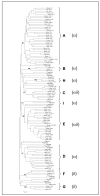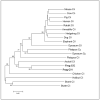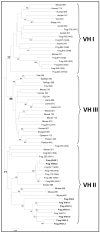The dynamic TCRδ: TCRδ chains in the amphibian Xenopus tropicalis utilize antibody-like V genes
- PMID: 20486124
- PMCID: PMC3086071
- DOI: 10.1002/eji.201040515
The dynamic TCRδ: TCRδ chains in the amphibian Xenopus tropicalis utilize antibody-like V genes
Abstract
The content and organization of the Xenopus tropicalis TCRα/δ locus was determined. This locus is highly conserved among tetrapods, with the genes encoding the TCRδ chains embedded with those encoding TCRα. However, the frog TCRα/δ is unusual in that it contains V genes that appear indistinguishable from those in the IgH locus (VH). These V genes, termed VHδ, make up 70% of the V genes at the TCRδ locus and are expressed exclusively in TCRδ chains. Finding TCRδ chains that use antibody-like V domains in frogs is similar to the situation in shark TCRδ variants and TCRμ in marsupials. These results suggest that such unconventional TCR may be more widespread across vertebrate lineages than originally thought and raise the possibility of previously unrealized subsets of T cells. We also revealed close linkage of TCRα/δ, IgH, and Igλ in Xenopus which, in combination with linkage analyses in other species, is consistent with the previous models for the emergence of these antigen receptor loci.
Figures









Similar articles
-
A model for the evolution of the mammalian t-cell receptor α/δ and μ loci based on evidence from the duckbill Platypus.Mol Biol Evol. 2012 Oct;29(10):3205-14. doi: 10.1093/molbev/mss128. Epub 2012 May 15. Mol Biol Evol. 2012. PMID: 22593227 Free PMC article.
-
A second TCRδ locus in Galliformes uses antibody-like V domains: insight into the evolution of TCRδ and TCRμ genes in tetrapods.J Immunol. 2012 Apr 15;188(8):3912-9. doi: 10.4049/jimmunol.1103521. Epub 2012 Mar 9. J Immunol. 2012. PMID: 22407916 Free PMC article.
-
Ancient Use of Ig Variable Domains Contributes Significantly to the TCRδ Repertoire.J Immunol. 2019 Sep 1;203(5):1265-1275. doi: 10.4049/jimmunol.1900369. Epub 2019 Jul 24. J Immunol. 2019. PMID: 31341077 Free PMC article.
-
Enforcing order within a complex locus: current perspectives on the control of V(D)J recombination at the murine T-cell receptor alpha/delta locus.Immunol Rev. 2004 Aug;200:224-32. doi: 10.1111/j.0105-2896.2004.00155.x. Immunol Rev. 2004. PMID: 15242408 Review.
-
The Evolution and Structure of Atypical T Cell Receptors.Results Probl Cell Differ. 2015;57:265-78. doi: 10.1007/978-3-319-20819-0_11. Results Probl Cell Differ. 2015. PMID: 26537385 Review.
Cited by
-
Comparative analysis of the chicken TCRα/δ locus.Immunogenetics. 2012 Aug;64(8):641-5. doi: 10.1007/s00251-012-0621-5. Epub 2012 May 17. Immunogenetics. 2012. PMID: 22592501 Free PMC article.
-
A model for the evolution of the mammalian t-cell receptor α/δ and μ loci based on evidence from the duckbill Platypus.Mol Biol Evol. 2012 Oct;29(10):3205-14. doi: 10.1093/molbev/mss128. Epub 2012 May 15. Mol Biol Evol. 2012. PMID: 22593227 Free PMC article.
-
Characterization of immunoglobulin loci in the gigantic genome of Ambystoma mexicanum.Front Immunol. 2023 Jan 27;14:1039274. doi: 10.3389/fimmu.2023.1039274. eCollection 2023. Front Immunol. 2023. PMID: 36776846 Free PMC article.
-
TR Locus Annotation and Characteristics of Rhinolophus ferrumequinum.Front Immunol. 2021 Sep 30;12:741408. doi: 10.3389/fimmu.2021.741408. eCollection 2021. Front Immunol. 2021. PMID: 34659234 Free PMC article.
-
Identification and characterization of TCRγ and TCRδ chains in channel catfish, Ictalurus punctatus.Immunogenetics. 2014 Oct;66(9-10):545-61. doi: 10.1007/s00251-014-0793-2. Epub 2014 Aug 17. Immunogenetics. 2014. PMID: 25129471
References
-
- Davis MM, Chein YH. T cell antigen receptors. In: Paul WE, editor. Fundamental Immunology. 6th ed. Lippincott; Philadelphia: 2008. pp. 313–345.
-
- Saito T. T cell antigen receptor, structure, expression and function. Hum. Cell. 1990;3:183–192. - PubMed
-
- Litman GW, Anderson MK, Rast JP. Evolution of antigen binding receptors. Annu. Rev. Immunol. 1999;17:109–147. - PubMed
-
- Chien YH, Gascoigne NR, Kavaler J, Lee NE, Davis MM. Somatic recombination in a murine T-cell receptor gene. Nature. 1984;309:322–326. - PubMed
Publication types
MeSH terms
Substances
Grants and funding
LinkOut - more resources
Full Text Sources

